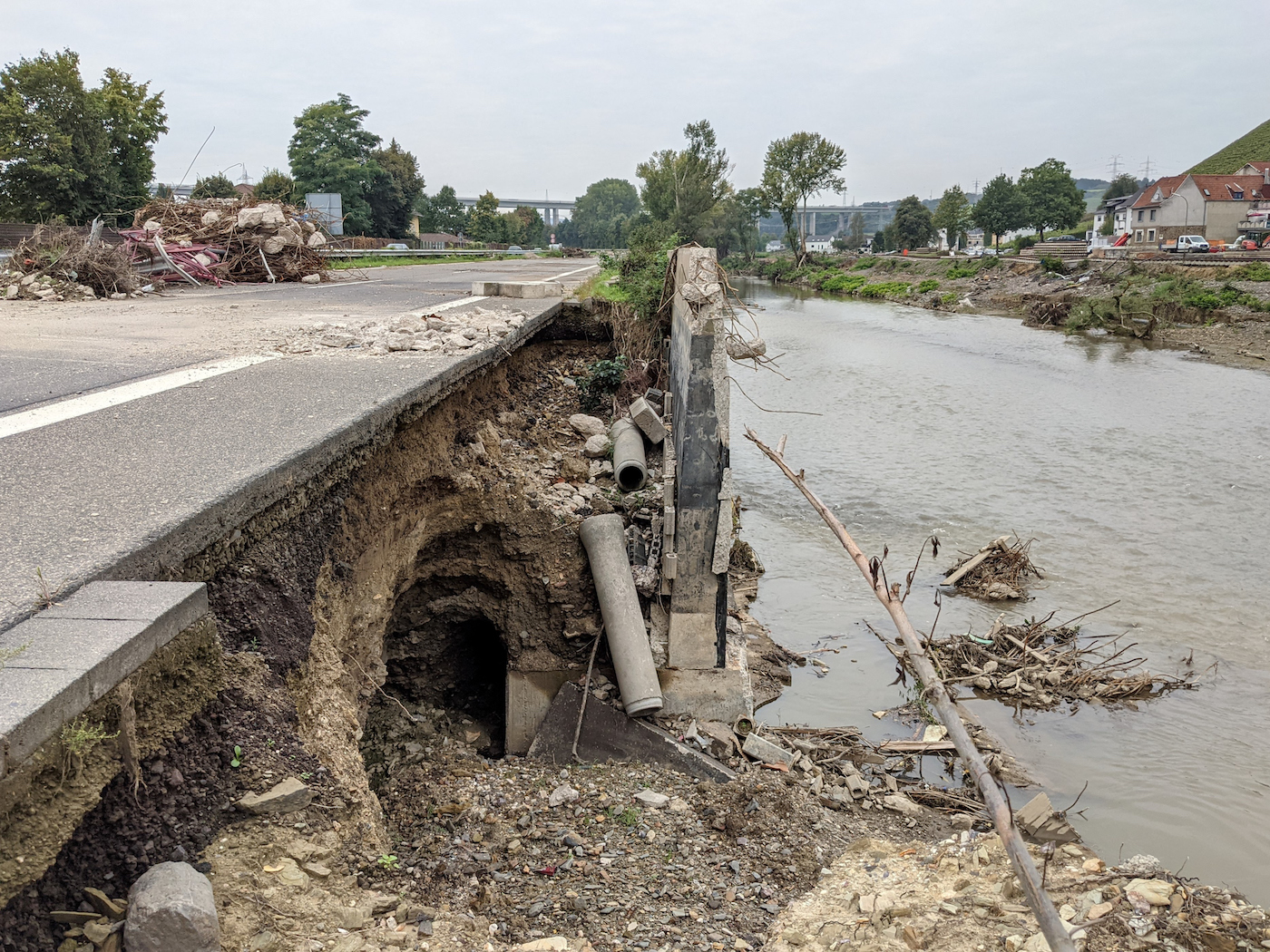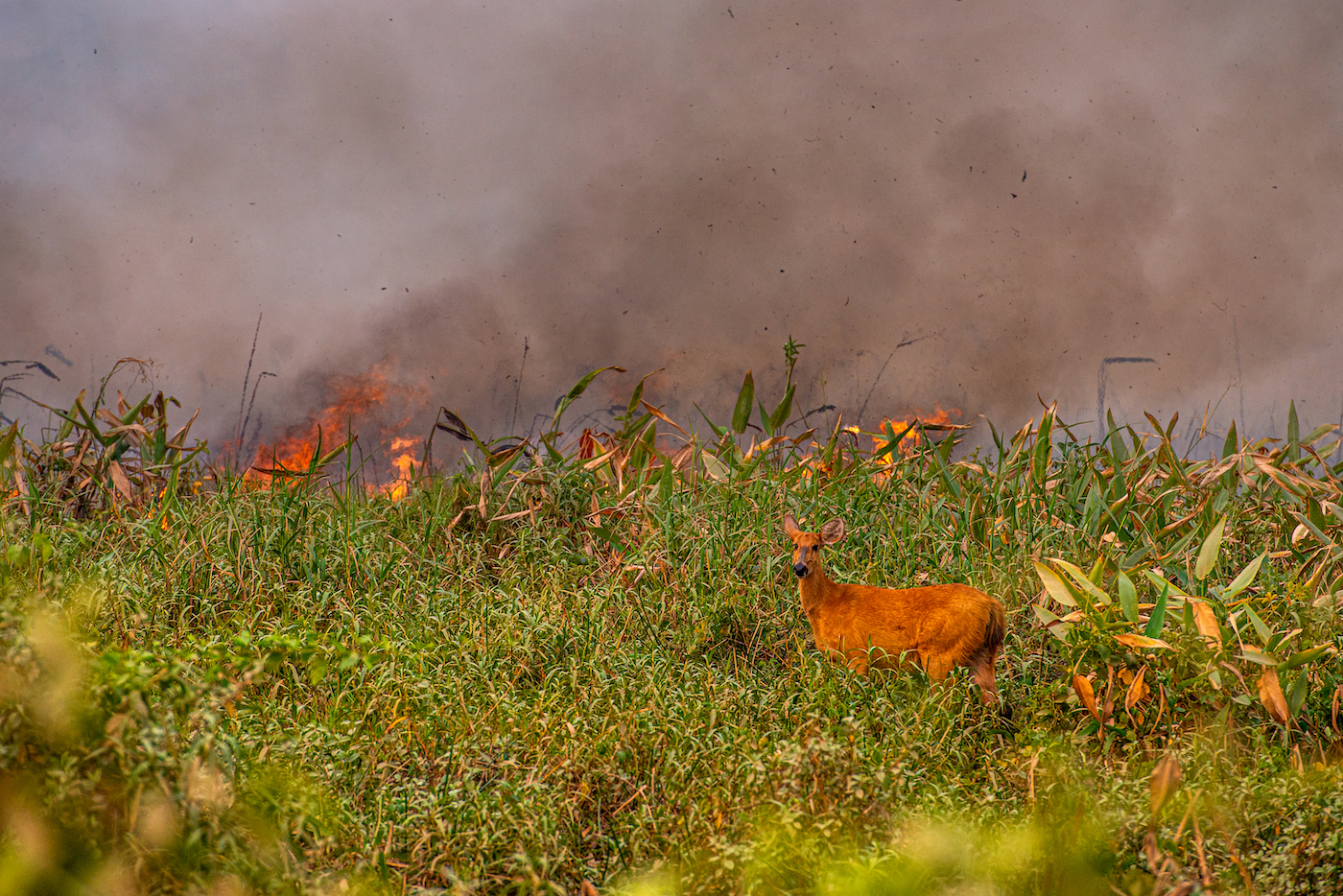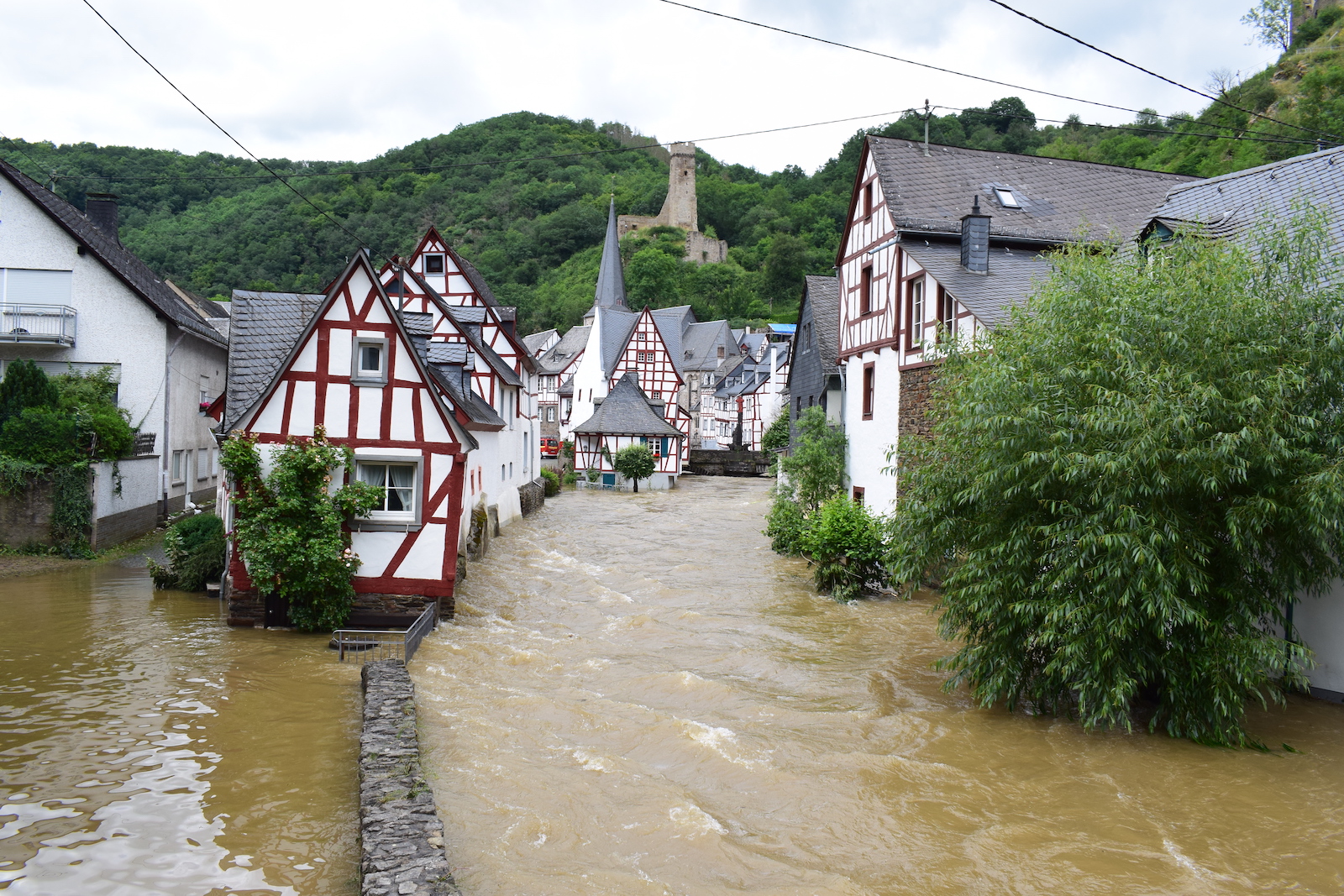This story was originally published by Yale Environment 360 and is reproduced here as part of the Climate Desk collaboration.
One balmy summer evening in mid-July last year, the tiny river Kyll flowing out of the Eifel Mountains in Germany turned from its normal placid flow into a raging torrent that engulfed several riverside towns in its path. By the morning, more than 220 people had died here and along several other German and Belgian mountain rivers. It was the worst flood disaster in Western Europe in several decades.
Politicians rushed to blame climate change for the intense rains that flooded the rivers that night. The world had to be “faster in the battle against climate change,” said German Chancellor Angela Merkel, as she toured devastated communities. Climate scientists later concluded that a warmer atmosphere had made such downpours up to nine times more likely.
But there was another factor behind the floods that few politicians or media have mentioned, then or since. Hydrologists monitoring the river flows say that the spread of farms in the once-boggy hills where the rainfall was most intense had destroyed the sponge-like ability of the land to absorb heavy rains. Field drains, roadways, and the removal of natural vegetation channeled the water into the rivers within seconds, rather than days.
That suggested a way to prevent future floods here and elsewhere that would be much faster than fixing climate change. Unpublished analysis of the Kyll by Els Otterman and colleagues at Dutch consultantcy Stroming, reviewed by Yale Environment 360, had found that blocking drains and removing dykes to restore half of the former sponges could reduce peak river flows during floods by more than a third.
Of course both climate change and land drainage were important in causing the floods. But while one will take decades of international action to fix, the other could be healed locally.
This is not just about what happened in Germany. There is a growing debate among environmental scientists about whether it is counterproductive to always focus on climate change as a cause of such disasters. Some say it sidelines local ways of reducing vulnerability to extreme weather and that it can end up absolving policymakers of their own failures to climate-proof their citizens.
“Stop blaming the climate for disasters,” says Friederike Otto of Imperial College London, a climatologist who is co-founder of World Weather Attribution, an international collaboration of scientists dedicated to identifying the underlying causes of weather-related disasters. She is determined to call out climate change where it contributes to disaster but cautions that “disasters occur when hazards [such as climate change] meet vulnerability.” And vulnerability has many causes, including bad water or forest management, unplanned urbanization, and social injustices that leave the poor and marginalized at risk.
The danger too, she concluded in a paper in January with Emmanuel Raju, a disaster researcher at the University of Copenhagen, and Emily Boyd of Lund University in Sweden, is that knee-jerk attribution of disasters to climate change creates “a politically convenient crisis narrative … [that] paves a subtle exit path for those responsible for creating vulnerability.”

Jesse Ribot, of American University, and Myanna Lahsen, of Linkoping University in Sweden, agree. “While politicians may want to blame crises on climate change, members of the public may prefer to hold government accountable for inadequate investments in flood or drought prevention and precarious living conditions,” they write in a paper published in December.
“A really striking example is the current food crisis in Madagascar, which has been blamed on climate change quite prominently,” Otto told e360. Last October, the UN’s World Food Programme said more than a million people in the south of the African country were starving after successive years of drought. Its warning that the disaster “could become the first famine caused by climate change” was widely reported. Madagascar’s President Andry Rajoelina said: “My countrymen are paying the price for a climate crisis that they did not create.”
But in December, Luke Harrington of the New Zealand Climate Research Institute concluded that climate change played at most a minor role in the drought, which was a reflection of past natural variability in rainfall, as evidenced by records dating back to the late 19th century. He instead pinned the blame for the crisis on poverty and poor infrastructure, such as inadequate water supplies to irrigate crops — issues that had gone unaddressed by Rajoelina’s government.
An even more glaring example may be how climate change is blamed for the continuing dry state of Lake Chad in West Africa and its huge security and humanitarian consequences.
Half a century ago, Lake Chad covered an area the size of Massachusetts. But during the final quarter of the 20th century, its surface shrank by 95 percent, and it remains today less than half the size of Rhode Island. Deprived of water, local fishers, farmers, and herders have lost their livelihoods. Deepening poverty has contributed to a collapse of law and order, growing jihadism, and an exodus of more than 2 million people, many heading for Europe.
Nigeria’s president Muhammadu Buhari says it is clear where the blame lies. “Climate change is largely responsible for the drying up of Lake Chad,” he told an investors summit last year. The African Development Bank has called the shriveled lake “a living example of the devastation climate change is wreaking on Africa”.
But there is another explanation. While the initial decline in the lake was clearly due to long droughts in the 1970s and 1980s, which some have linked to climate change, the lake has remained stubbornly empty over the past two decades, while rainfall has recovered. Why? Hydrologists say the answer is that rivers out of Cameroon, Chad, and Buhari’s Nigeria that once supplied most of its water are being diverted by government agencies to irrigate often extremely inefficient rice farms.
A 2019 analysis headed by Wenbin Zhu, a hydrologist at the Chinese Academy of Sciences, found that water diversions for irrigation explained 73 percent of the reduction in flow into Lake Chad from the largest river, the Chari, since the 1960s — a proportion that rose to 80 percent after 2000. Variability in rainfall explained just 20 percent.
Robert Oakes of the United Nations University’s Institute for Environment and Human Security in Bonn says that “the climate-change framing has prevented the identification and implementation of appropriate measures to address the challenges.” Those measures include restoring flow to the rivers that once fed the lake.
Some warn that any effort to downplay the importance of climate change in such disasters as providing succor to deniers of what British TV naturalist David Attenborough told a UN Security Council meeting last year represents the “biggest threat modern humans have ever faced.” And that in any case it is misguided since, in the words of UN Secretary-General Antonio Guterres at the same meeting, climate change is a “crisis multiplier” that makes every other issue worse.

Kevin Trenberth of the National Center for Atmospheric Research has argued that, “because global warming is unequivocal,” the conventional approach to climate-change attribution should no longer start from an assumption of no impact – the null hypothesis — and then try to prove otherwise. Instead “the reverse should now be the case. The task, then, could be to prove there is no anthropogenic component to a particular observed change in climate.”
There is growing concern too that the international community’s focus on climate change is skewing other conservation priorities.
“Threats to biodiversity are increasingly seen through the single myopic lens of climate change,” complains Tim Caro, an evolutionary ecologist at the University of California Davis. That is hard to justify when his analysis of Red List extinction data shows that habitat loss is still three times more important than climate change in vertebrate extinctions. Ignoring this fact, he says, is undermining strategies needed to prevent deforestation and other threats to habitat.
The assumption that forest wildfires in the American West and elsewhere are escalating predominantly because of climate change may also hamper action to prevent the fires.
In late 2020, as his state’s forests burned, the governor of Washington, Jay Inslee, declared, “This is not an act of God. This has happened because we have changed the climate.” He was not wrong. An attribution analysis by Otto, of Imperial College London, and others found that the heat wave in the Pacific Northwest in July would have been “virtually impossible” without global warming.
But there are other causes for the infernos, notably misguided fire suppression that over many decades has dramatically increased the amount of fuel on the forest floor. Of course, we should halt climate change, says fire researcher Crystal Kolden of the University of California, Merced. But without a radical increase in deliberate controlled fires to reduce the fuel available during the lengthening fire season, “more catastrophic wildfire disasters are inevitable.” Forestry practice is changing, but she reckons California should be doing five times more prescribed burning.
Other ecosystems need similar TLC. Take the Pantanal in the heart of South America, the world’s largest tropical wetland. Up to a quarter of the Pantanal was on fire during 2020. With temperatures in the region up 3.6 degrees F since 1980, and humidity down 25 percent, it is hardly surprising that discussions in Brazil have “emphasized climate change as almost the sole driver” of the fires, according to Rafaela Nicola, who heads the nonprofit Wetlands International in Brazil. Even Brazilian President Jair Bolsonaro, a climate-change skeptic, called the fires “an inevitable consequence” of high temperatures.

“No doubt climate changes intensified the situation,” says Nicola. “However other drivers are key.” Encouraged by Bolsonaro’s land policies, farmers have been advancing into the north of the Pantanal, where most of the fires occurred. “The highest concentrations of fire foci are adjacent to the agricultural frontier,” concluded Juliana Fazolo Marquez of the Federal University of Ouro Preto, after a detailed mapping.
The climatic conditions in 2020 were exceptional, but Brazil’s government “is ignoring the causes of the fires: a combination of inadequate fire management, climate extremes, human behavior and weak environmental regulations,” says Renata Libonati, a forest ecologist at the Federal University of Rio de Janeiro.
At the Glasgow climate conference last November, rich nations promised to spend tens of billions of dollars helping poorer nations adapt to climate change. All well and good, says Otto. But she “fears very much” that this money will be spent on the wrong things. The Nigerian government has been pushing for Lake Chad to be refilled by diverting water 2,400 kilometers from the Congo River in central Africa. Bizarrely, the proposed canal would take the water right past the irrigation projects currently leaving the lake empty.
Meanwhile, many policymakers in rich nations have not gotten wise to the fact that adaptation is needed at home too. In Europe, ecologists estimate that up to 90 percent of the continent’s former wetland sponges have lost capacity to absorb water, mostly due to drainage for urban development and agriculture, resulting in the floods that engulfed parts of Germany last summer.
Jane Madgwick, CEO of Wetlands International, estimates that sponges across 50,000 square miles of upland river catchments across Germany, France, Belgium, and Luxembourg could be restored to reduce flood peaks downstream. “Yes, of course we need to fight climate change,” she says. But in the meanwhile, “extreme meteorological events don’t have to turn into extreme flooding events. As we work to fix the climate, we must fix the landscape too.”



